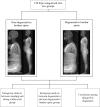Variations in lower limb alignments indicate pelvic tilt after total hip arthroplasty
- PMID: 36544147
- PMCID: PMC9773480
- DOI: 10.1186/s12891-022-06032-y
Variations in lower limb alignments indicate pelvic tilt after total hip arthroplasty
Abstract
Objective: We sought to correlate various spinopelvic and lower limb alignments, and to examine the current spinopelvic theories on a Chinese cohort.
Methods: We retrospectively reviewed 166 patients undergoing THA. Among them, 138 patients with unilateral THA met the inclusion criteria. Sagittal alignments and cup orientations were measured on standing and sitting lateral EOS images. Patients were categorized into two groups with a scoring system for lumbar spine degeneration. Patients' demographics including age, sex, lumbar spine degeneration and radiographic measurements were studied.
Results: PT, SS, LL and TK differed significantly between standing and sitting within each group except for TK in degenerative group (32.8 ± 13.9 vs. 32.9 ± 14.2, p = 0.905). Compared with degenerative spine group, non-degenerative spine patients have great pelvic mobility (ΔPT, -24.4 ± 12.5° vs. -17.6 ± 10.7, p = 0.0008), greater lumbar mobility (ΔLL, -34.8 ± 15.2 vs. -21.7 ± 12.2, p = < 0.0001) and compensatory cup orientation changes (ΔRA, -15.5 ± 11.1 vs. -12.0 ± 8.4, p = 0.00920; ΔRI, -10.8 ± 11.5 vs. -5.6 ± 7.5, p = 0.0055). Standing PT and ankle dorsiflexion angle correlated positively (R2 = 0.236, p = 0.005).
Conclusion: THA patients in this cohort showed a spinopelvic motion paradigm similar to that from previous studies on Caucasians. Ankle dorsiflexion indicate greater posterior pelvic tilt on standing. Surgeons should beware of risks of instability in patients with lower limb compensations.
Advances in knowledge: This study provides new insights into the clinical relevance of lower limb alignments to spinopelvic motion after THA in a relatively young Chinese population.
Keywords: Instability; Lower limb alignment; Spinal sagittal balance; Spinopelvic mobility; Total hip arthroplasty.
© 2022. The Author(s).
Conflict of interest statement
The authors declare that they have no competing interests.
Figures


References
-
- Lewinnek G, Lewis J, Tarr R, Compere C, Zimmerman J. Dislocations after total hip-replacement arthroplasties. J Bone Joint Surg Am. 1978;60(2):217–20. - PubMed
MeSH terms
Grants and funding
LinkOut - more resources
Full Text Sources
Medical
Miscellaneous

